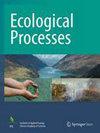气候变暖和降水变化很少改变N添加对土壤温室气体通量的影响:一项荟萃分析
IF 3.9
2区 环境科学与生态学
Q1 ECOLOGY
引用次数: 0
摘要
氮(N)添加引起的土壤温室气体(GHG)通量变化被认为是导致全球气候变化(全球变暖和降水变化)的关键因素,而降水变化反过来又改变了氮添加与土壤温室气体通量之间的反馈关系。然而,在气候变化条件下,氮素添加对土壤温室气体排放的影响是高度可变和依赖于环境的,因此需要进一步的综合研究。本文通过综合57篇同行评议的全球多个陆地生态系统文章中的2103个观测值,对氮添加与气候变化(变暖和降水改变)对3种主要土壤温室气体[二氧化碳(CO2)、甲烷(CH4)和氧化亚氮(N2O)]通量的相互作用进行了荟萃分析。氮添加与气候变化对温室气体通量的交互作用总体上呈叠加效应。N添加与增温或降水变化的组合显著增加了N2O排放,而对CO2排放和CH4吸收的影响很小,对CH4排放的影响尚不能评价。此外,综合效应的大小与单独添加N的影响没有显著差异。显然,不同生态系统类型对CO2和CH4的综合影响因土壤湿度的不同而不同,这与土壤N2O排放的响应相反。不同气候条件和试验方法下,土壤温室气体通量对N添加和气候变化的响应也存在差异。总体而言,氮添加和气候变化对土壤温室气体通量的影响是相对独立的,即氮添加和气候变化的综合效应等于或不显着差异于各自个体效应的总和。氮添加对土壤温室气体通量的影响影响气候变化与土壤温室气体通量之间的反馈关系。本文章由计算机程序翻译,如有差异,请以英文原文为准。
Warming and altered precipitation rarely alter N addition effects on soil greenhouse gas fluxes: a meta-analysis
Changes in soil greenhouse gas (GHG) fluxes caused by nitrogen (N) addition are considered as the key factors contributing to global climate change (global warming and altered precipitation regimes), which in turn alters the feedback between N addition and soil GHG fluxes. However, the effects of N addition on soil GHG emissions under climate change are highly variable and context-dependent, so that further syntheses are required. Here, a meta-analysis of the interactive effects of N addition and climate change (warming and altered precipitation) on the fluxes of three main soil GHGs [carbon dioxide (CO2), methane (CH4), and nitrous oxide (N2O)] was conducted by synthesizing 2103 observations retrieved from 57 peer-reviewed articles on multiple terrestrial ecosystems globally. The interactive effects of N addition and climate change on GHG fluxes were generally additive. The combination of N addition and warming or altered precipitation increased N2O emissions significantly while it had minimal effects on CO2 emissions and CH4 uptake, and the effects on CH4 emissions could not be evaluated. Moreover, the magnitude of the combined effects did not differ significantly from the effects of N addition alone. Apparently, the combined effects on CO2 and CH4 varied among ecosystem types due to differences in soil moisture, which was in contrast to the soil N2O emission responses. The soil GHG flux responses to combined N addition and climate change also varied among different climatic conditions and experimental methods. Overall, our findings indicate that the effects of N addition and climate change on soil GHG fluxes were relatively independent, i.e. combined effects of N addition and climate change were equal to or not significantly different from the sum of their respective individual effects. The effects of N addition on soil GHG fluxes influence the feedbacks between climate change and soil GHG fluxes.
求助全文
通过发布文献求助,成功后即可免费获取论文全文。
去求助
来源期刊

Ecological Processes
Environmental Science-Ecological Modeling
CiteScore
8.50
自引率
4.20%
发文量
64
审稿时长
13 weeks
期刊介绍:
Ecological Processes is an international, peer-reviewed, open access journal devoted to quality publications in ecological studies with a focus on the underlying processes responsible for the dynamics and functions of ecological systems at multiple spatial and temporal scales. The journal welcomes manuscripts on techniques, approaches, concepts, models, reviews, syntheses, short communications and applied research for advancing our knowledge and capability toward sustainability of ecosystems and the environment. Integrations of ecological and socio-economic processes are strongly encouraged.
 求助内容:
求助内容: 应助结果提醒方式:
应助结果提醒方式:


